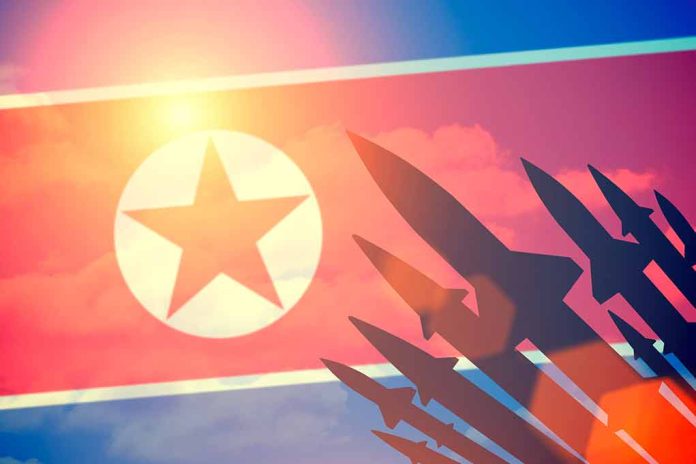
North Korea fears Trump’s “Golden Dome” missile defense system will trigger a global nuclear arms race, calling it a “very dangerous threatening initiative” aimed directly at undermining their strategic security.
Key Takeaways
- North Korea has strongly condemned President Trump’s “Golden Dome” missile shield plan, warning it could lead to nuclear conflict in space
- President Trump has already secured initial funding for the system, describing it as “very important for the success and even survival of our country”
- Experts believe North Korea views the Golden Dome as a significant threat to its nuclear arsenal’s effectiveness, potentially triggering new countermeasures
- China and Russia have joined North Korea in expressing concerns, with China accusing the US of undermining global stability
- The ambitious defense initiative faces substantial technical, political, and financial challenges according to analysts
North Korea’s Alarming Response to American Defense Innovation
North Korea has issued a sharp rebuke of President Trump’s “Golden Dome” missile defense system, characterizing it as a dangerous provocation that threatens to destabilize global security. Through state media, Pyongyang’s Foreign Ministry condemned the initiative in unusually strong language, labeling it “a very dangerous ‘threatening initiative’ aimed at threatening the strategic security of the nuclear weapons states,” According to Pyongyang’s Foreign Ministry. The regime’s intense reaction highlights growing concerns about America’s expanding military capabilities in the region and suggests potential escalation in an already tense geopolitical landscape.
The North Korean response comes after President Trump secured initial funding and announced details of the ambitious missile shield program, which he described as the “Golden Dome” – a system inspired by Israel’s Iron Dome but designed to counter more sophisticated long-range missile threats. The President emphasized the critical nature of this defense initiative, stating it is “very important for the success and even survival of our country,” Stated Donald Trump, President of the United States.
Strategic Implications and International Fallout
North Korea’s objections to the Golden Dome system extend beyond mere rhetoric – they reflect genuine strategic concerns about the potential neutralization of their nuclear deterrent capabilities. Experts believe Pyongyang views this development as a direct challenge to its security doctrine, which relies heavily on the threat of nuclear retaliation. “The North’s strong reaction suggests it views the Golden Dome as capable of significantly weakening the effectiveness of its nuclear arsenal, including its ICBMs,” Stated Hong Min, a senior analyst at the Korea Institute for National Unification.
North Korea is not alone in its apprehension. Both China and Russia have expressed similar concerns about the American missile defense initiative. The Kremlin has called for consultations with Moscow, though it acknowledged the program as a sovereign American matter. China has taken a more confrontational stance, accusing the United States of undermining global stability and potentially triggering a new arms race. This growing coalition of opposition suggests the Golden Dome could become a significant point of contention in international relations, particularly as the US continues to expand its military presence in East Asia.
Technical Challenges and Regional Security Dynamics
While the Golden Dome represents an ambitious leap forward in American missile defense capabilities, analysts note that the system faces substantial technical and political hurdles. The financial cost alone could be prohibitive, with estimates suggesting a massive investment would be required to create a comprehensive space-based missile shield. Additionally, the technical challenges of intercepting sophisticated hypersonic weapons being developed by adversaries like China and Russia remain formidable. The Pentagon has acknowledged the rapid advancement in missile technology by these nations, with both countries actively modernizing their strategic capabilities.
For North Korea, the increasing American military presence in the region represents what they perceive as an existential threat. Pyongyang routinely characterizes joint US-South Korean military exercises as rehearsals for invasion. The introduction of the Golden Dome system will likely accelerate North Korea’s own weapons development programs as it seeks to maintain what it considers a credible deterrent. This dynamic threatens to create a dangerous cycle of escalation, with each defensive measure prompting more advanced offensive capabilities, further destabilizing an already volatile region.
America’s Strategic Calculus
President Trump’s decision to pursue the Golden Dome system reflects a broader strategic vision focused on American security in an increasingly complex threat environment. Named in a nod to Israel’s Iron Dome but designed to address far more sophisticated threats, the system represents a significant evolution in American defense thinking. Unlike its Israeli counterpart, which counters short-range rockets, the Golden Dome aims to neutralize intercontinental ballistic missiles and potentially hypersonic weapons that could threaten the American mainland.
Despite international criticism, the administration appears committed to advancing this initiative as a cornerstone of American defense policy. The system aligns with President Trump’s broader emphasis on maintaining American technological superiority and reducing vulnerability to foreign threats. As tensions with North Korea, China, and Russia continue to simmer, the Golden Dome represents not just a defensive measure but a statement of American resolve to protect its homeland regardless of international opposition or concerns about triggering a new arms race.



